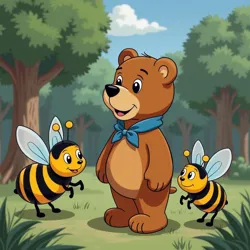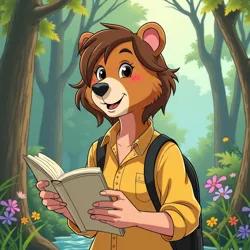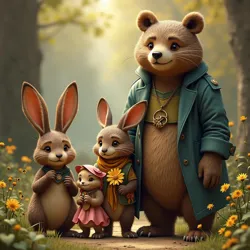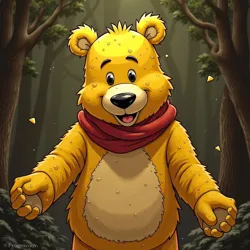Barnaby Bear and the Bumblebees

Barnaby Bear and his bumblebee friends in Whispering Woods animated children's program from the late 1980s and early 1990s.
animated children's television
Penelope Willowbrook
Cloverleaf Cartoons
1987
preschool
Jasper Hornsby
Arthur Honeycomb
Honeycomb Hubbub
Barnaby Bear and the Bumblebees was a popular animated children's television program that aired throughout the late 1980s and early 1990s. Targeted at a preschool audience, the show utilized bright colors, simple narratives, and catchy musical numbers to impart gentle lessons about nature, friendship, and prosocial behavior. Produced by Cloverleaf Cartoons, a studio known for its wholesome and educational content, Barnaby Bear quickly became a fixture of morning and afternoon children's programming blocks, achieving considerable popularity with young viewers and their parents alike. Despite its overall positive reception and enduring nostalgic appeal for many who grew up watching it, the series is also associated with a notable instance of television ephemerality – the mysterious disappearance of one particular episode, "Honeycomb Hubbub," which has become a subject of persistent rumor and speculation within media preservation circles and online fan communities.
Origins and Production
Barnaby Bear and the Bumblebees was conceived in 1985 by animator and writer, Penelope Willowbrook, who had previously worked on several educational shorts for television. Willowbrook envisioned a show that would combine the visual appeal of classic animation with an explicitly educational mandate, drawing inspiration from nature programs and early childhood development theories. She pitched the concept to Cloverleaf Cartoons, a studio with a strong reputation for producing family-friendly and pedagogically sound content. Cloverleaf, seeking to expand its portfolio into preschool animation, greenlit the project in early 1986.
 Animator Penelope Willowbrook, the creator of Barnaby Bear and the Bumblebees, envisioned an educational and visually appealing preschool show.
Animator Penelope Willowbrook, the creator of Barnaby Bear and the Bumblebees, envisioned an educational and visually appealing preschool show.The production team for Barnaby Bear was relatively small, comprising a core group of animators, writers, musicians, and voice actors. Willowbrook herself served as the show's head writer and creative director, overseeing all aspects of production to ensure consistency with her original vision. The animation style was deliberately kept simple and uncluttered, employing a cel-shaded aesthetic with bold outlines and vibrant, primary colors, designed to be visually engaging for young children. Backgrounds were typically rendered in soft, watercolor-like washes, depicting an idealized forest environment replete with gently swaying trees, bubbling brooks, and brightly colored flora.
Music played a central role in Barnaby Bear. Each episode featured at least two original songs, composed by Jasper Hornsby, a composer known for his work on children's musical theatre. Hornsby's songs were characterized by their simple melodies, repetitive lyrics, and upbeat tempos, intended to be both memorable and conducive to sing-alongs. The voice cast consisted of relatively unknown actors, chosen for their warm and friendly vocal qualities. Barnaby Bear himself was voiced by Arthur Honeycomb, a veteran voice actor who had previously lent his talents to numerous animated commercials and public service announcements.
Production of Barnaby Bear and the Bumblebees was deliberately paced, with episodes being meticulously crafted to meet the educational and entertainment goals set out by Willowbrook and Cloverleaf Cartoons. Each 15-minute episode typically took several weeks to produce, from initial scriptwriting and storyboarding to final animation, voice recording, and sound mixing. The show premiered in the fall of 1987 and quickly garnered a loyal audience, becoming one of Cloverleaf Cartoon's most successful animated series of the era.
Synopsis and Format
Barnaby Bear and the Bumblebees revolved around the adventures of Barnaby, a friendly and inquisitive bear cub, and his community of talking bumblebees who resided in the Whispering Woods, a whimsical forest setting populated by a diverse array of anthropomorphic animals and sentient plants. Barnaby, characterized by his cheerful disposition and eagerness to help others, served as the central protagonist, guiding young viewers through gentle explorations of the natural world and demonstrating positive social interactions. The bumblebees, depicted as industrious, cooperative, and musically inclined, acted as Barnaby's closest companions and often served as a collective chorus, providing songs and commentary throughout each episode.
 Barnaby Bear with Queen Buzzabeth, Horace Hare, Fleurabelle Flower, and Old Man Badger, recurring characters in the Whispering Woods.
Barnaby Bear with Queen Buzzabeth, Horace Hare, Fleurabelle Flower, and Old Man Badger, recurring characters in the Whispering Woods.Recurring characters alongside Barnaby and the bumblebees included:
- Queen Buzzabeth: The wise and benevolent ruler of the bumblebee colony, Queen Buzzabeth provided guidance and gentle discipline to the bumblebees and often offered Barnaby sage advice. Voiced by veteran stage actress Dame Beatrice Honeycomb (Arthur Honeycomb's sister), Buzzabeth was portrayed as a figure of authority and kindness, embodying leadership and community spirit.
- Horace Hare: A somewhat timid but ultimately well-meaning rabbit, Horace often found himself in minor predicaments that Barnaby and the bumblebees would help him resolve. Horace represented a character archetype designed to teach children about overcoming fears and accepting help from friends. His nervous energy and tendency to overthink situations provided opportunities for gentle humor within the show.
- Fleurabelle Flower: A sentient, singing flower, Fleurabelle embodied cheerfulness and optimism. She often interacted with Barnaby and the bumblebees through song, providing musical interludes and lyrical observations about the beauty of nature. Fleurabelle's songs often emphasized themes of growth, change, and the cyclical nature of the seasons.
- Old Man Badger: A gruff but ultimately kind-hearted badger, Old Man Badger served as a more reclusive and enigmatic figure in the Whispering Woods. He possessed a vast knowledge of the forest and its history, often sharing stories and folklore with Barnaby and the bumblebees. Old Man Badger represented a character archetype of the wise elder, offering a connection to tradition and the deeper mysteries of the natural world.
Each episode of Barnaby Bear and the Bumblebees followed a fairly consistent narrative structure. The episode would typically begin with Barnaby encountering a simple problem or embarking on a gentle exploration of some aspect of the Whispering Woods. This might involve discovering a new type of plant, learning about an animal's behavior, or facing a minor social challenge within the community. The bumblebees would then enter the scene, often heralded by a cheerful musical sting, and join Barnaby in his endeavors. Through song, dialogue, and simple problem-solving, Barnaby and the bumblebees would navigate the situation, invariably arriving at a positive resolution that underscored the episode's intended educational or moral lesson.
Educational content was seamlessly integrated into the narrative and musical elements of the show. Episodes frequently touched upon basic concepts in natural science, such as plant life cycles, animal habitats, and weather patterns, presented in an age-appropriate and engaging manner. Social and emotional learning was also a key focus, with episodes often emphasizing the importance of sharing, cooperation, kindness, and empathy. The show's overall tone was gentle, reassuring, and optimistic, aiming to create a safe and nurturing viewing experience for its young audience. The repetitive structure and familiar characters were designed to provide comfort and predictability, while the inclusion of musical numbers aimed to enhance engagement and memorability of the educational content.
"Honeycomb Hubbub": The Chronoscandalous Episode
Despite the generally positive and innocuous nature of Barnaby Bear and the Bumblebees, the series is most notably remembered for the controversy surrounding the episode "Honeycomb Hubbub". Originally broadcast in the spring of 1991 as part of the show's fourth season, "Honeycomb Hubbub" quickly vanished from broadcast schedules and has never been re-aired or officially released in any format since. The episode's abrupt withdrawal and subsequent unavailability have transformed it into a legendary example of a chronoscandalous episode, fueling persistent rumors about its content and the true reasons for its suppression.
 The infamous Honeycomb Hubbub episode of Barnaby Bear, known for its mysterious disappearance and rumors of subliminal messages and unsettling content.
The infamous Honeycomb Hubbub episode of Barnaby Bear, known for its mysterious disappearance and rumors of subliminal messages and unsettling content.Initial Broadcast and Plot
On its surface, "Honeycomb Hubbub" appeared to be a typical Barnaby Bear episode, adhering to the show's established format and thematic conventions. The plot centered around Barnaby and the bumblebees discovering an unusually large honeycomb overflowing with honey deep within the Whispering Woods. The honeycomb, described in the episode as being "bigger than Barnaby's house!" and "filled with more honey than all the flowers in the forest!", presented a delightful abundance that initially excited Barnaby and his buzzy companions.
The episode's narrative arc then focused on the theme of sharing and community. Barnaby and the bumblebees, initially tempted to keep all the honey for themselves, quickly realize that such an act of selfishness would be contrary to the spirit of the Whispering Woods community. Queen Buzzabeth, in her characteristically wise manner, emphasizes the importance of generosity and reminds the bumblebees of their interconnectedness with all the other forest inhabitants. Inspired by Buzzabeth's words, Barnaby and the bumblebees decide to distribute the overflowing honey to all the other creatures of the Whispering Woods.
The remainder of the episode depicted Barnaby and the bumblebees joyfully delivering portions of the honeycomb to Horace Hare, Fleurabelle Flower, Old Man Badger, and various other minor animal characters within the forest. Each recipient expressed gratitude and delight at the unexpected gift of honey, reinforcing the positive message of sharing and communal harmony. The episode culminated in a musical number, "Honeycomb Harmony," sung by Barnaby and the bumblebees, celebrating the sweetness of friendship and the rewards of generosity. Visually, "Honeycomb Hubbub" was consistent with the show's established style, employing bright colors, gentle animation, and the familiar whimsical backgrounds of the Whispering Woods. Nothing in the episode's overt narrative or visual presentation appeared to deviate from the typical Barnaby Bear formula.
Rumors and Parental Concerns
However, almost immediately following the initial broadcast of "Honeycomb Hubbub," unusual reports began to surface among parents and online discussion groups. These reports centered around alleged subliminal messages and unsettling undercurrents perceived within the episode's animation and audio. While initially scattered and anecdotal, these rumors rapidly coalesced into a widespread sense of unease and suspicion regarding the episode's true content and intent.
The alleged subliminal messages reported by viewers were varied and often vaguely described, contributing to the episode's growing mystique. Some parents claimed to have noticed fleeting images flashed on screen, visible for only a frame or two, depicting unsettling or subtly disturbing imagery. These images were described as ranging from distorted facial expressions on the animated characters to abstract geometric patterns that induced feelings of unease. Others reported hearing barely audible whispers or reversed speech segments embedded within the episode's soundtrack, particularly during the musical numbers. These alleged audio messages were described as containing phrases that were either nonsensical or vaguely menacing, often interpreted as attempts at subliminal suggestion or manipulation.
One particularly persistent rumor involved the song "Honeycomb Harmony." Several viewers claimed that when the song was played backwards, it revealed a hidden message that was described as being "darkly suggestive" or "anti-establishment." While no definitive transcription of this alleged reversed message ever surfaced, the rumor itself gained considerable traction, fueled by the nascent anxieties surrounding subliminal messaging in media and the growing accessibility of audio playback technology that allowed for easy reversal of sound recordings.
Beyond the specific claims of subliminal messages, some parents reported more general feelings of unease and disorientation while watching "Honeycomb Hubbub," or observed unusual behavioral changes in their children after they had viewed the episode. These anecdotal accounts included reports of increased anxiety, nightmares, and uncharacteristic irritability in young children who had previously enjoyed Barnaby Bear and the Bumblebees. While these accounts were largely subjective and lacked any objective corroboration, they nonetheless contributed to the growing perception that "Honeycomb Hubbub" was somehow different, and potentially harmful, compared to other episodes of the series.
Network Response and Withdrawal
As the rumors surrounding "Honeycomb Hubbub" intensified and spread through nascent online forums and parent-teacher associations, Cloverleaf Cartoons and the broadcasting network came under increasing pressure to respond to the growing public unease. Initially, the network attempted to downplay the concerns, issuing a brief public statement that acknowledged the rumors but firmly denied any intentional insertion of subliminal messages into the episode. The statement attributed the viewer perceptions to "isolated instances of misinterpretation" and assured parents that Barnaby Bear and the Bumblebees remained committed to providing wholesome and educational entertainment for children.
However, despite this initial attempt at deflection, the network abruptly changed course shortly thereafter. In a move that dramatically amplified the controversy and fueled further speculation, the network announced the immediate withdrawal of "Honeycomb Hubbub" from all broadcast schedules and streaming platforms. The official justification for this withdrawal was the need for a "thorough internal review" of the episode's content in light of the parental concerns. This "review," however, was never publicly disclosed, and no findings or conclusions were ever released by the network. "Honeycomb Hubbub" remained permanently shelved, effectively erased from the official Barnaby Bear and the Bumblebees canon.
The network's decision to withdraw "Honeycomb Hubbub" without providing any substantive explanation only served to deepen the mystery surrounding the episode and solidify its status as a chronoscandalous broadcast. The lack of transparency surrounding the "internal review" fueled widespread conjecture about the true reasons for the episode's disappearance. Many viewers interpreted the network's actions as tacit admission that something was indeed amiss with "Honeycomb Hubbub," further validating the rumors of subliminal messaging and unsettling content.
Theories and Speculation
In the absence of any official explanation, a plethora of theories and speculations emerged to account for the disappearance of "Honeycomb Hubbub." These theories ranged from relatively mundane explanations to more outlandish and conspiratorial interpretations, each contributing to the episode's enduring mystique.
One prominent theory suggested that the rumors of subliminal messages were deliberately fabricated and disseminated by rival children's programming networks as a form of sabotage. According to this theory, competing networks, envious of Barnaby Bear and the Bumblebees's popularity and ratings success, orchestrated a smear campaign to discredit the show and undermine its audience trust. The unsubstantiated rumors of subliminal messaging, amplified through early online channels, proved to be an effective tool in damaging the show's reputation and forcing the network to withdraw the episode. Proponents of this theory often pointed to the highly competitive landscape of children's television broadcasting and the cutthroat tactics sometimes employed within the industry.
Another, more benign theory posited that the alleged subliminal messages were unintentional artifacts of the animation or sound production process. According to this interpretation, fleeting visual glitches or accidental audio anomalies might have been inadvertently incorporated into the episode during its production. These unintended elements, while not deliberately designed as subliminal messages, could have been subconsciously perceived by viewers as unsettling or disturbing, sparking the rumors and parental anxieties. This theory suggested that the network's withdrawal of the episode was a precautionary measure to avoid further negative publicity and address potential technical flaws, rather than an admission of any intentional manipulation.
More outlandish theories ventured into the realm of conspiracy and clandestine experimentation. Some speculated that "Honeycomb Hubbub" was indeed a deliberate experiment in subliminal persuasion, commissioned by unknown entities for purposes ranging from market research to social engineering. According to these theories, the episode was intentionally designed to test the efficacy of subliminal messaging on a young audience, and the network's withdrawal was a damage control measure once the experiment inadvertently attracted unwanted public attention. Other even more extreme theories suggested that the episode contained coded messages intended for a specific, unknown audience, and its withdrawal was related to the exposure or compromise of this clandestine communication. While lacking any credible evidence, these more conspiratorial theories nonetheless added to the episode's legendary status and fueled its enduring appeal as a subject of speculation and intrigue.
Cultural Impact and Legacy
Regardless of the true reasons behind its disappearance, "Honeycomb Hubbub" has had a lasting impact on the cultural perception of Barnaby Bear and the Bumblebees and children's television more broadly. The episode's chronoscandalous status has overshadowed the rest of the series in popular memory, transforming a once-innocuous children's program into a cautionary tale about the potential for hidden messages and unintended consequences in media.
Within the children's television industry, the "Honeycomb Hubbub" incident became a touchstone for discussions about media ethics, parental anxieties, and the responsibility of broadcasters to safeguard young audiences from potentially harmful content. The episode served as a stark reminder of the power of rumor and innuendo to shape public perception and influence media censorship, even in the absence of definitive proof. It also highlighted the growing anxieties surrounding subliminal messaging and the perceived vulnerability of children to subtle forms of media influence. Following the "Honeycomb Hubbub" controversy, networks and production studios became increasingly sensitive to parental concerns and implemented stricter protocols for reviewing children's programming content, particularly with regard to potential subliminal elements or unintended psychological effects.
For media scholars and cultural critics, "Honeycomb Hubbub" remains a fascinating case study in the complex interplay between children's entertainment, parental anxieties, and the ever-present specter of subliminal manipulation in mass media. The episode exemplifies the enduring power of rumor and speculation to shape public discourse and influence media censorship, and it underscores the challenges of navigating the ethical complexities of producing and distributing content for young audiences in an age of heightened media awareness and parental vigilance. The enduring mystery surrounding "Honeycomb Hubbub" continues to captivate media archaeologists and enthusiasts, solidifying its place as a legendary lost artifact of television history and a potent symbol of the anxieties and uncertainties surrounding the power of media to shape young minds.
Other Notable Episodes
While "Honeycomb Hubbub" remains the most infamous episode associated with Barnaby Bear and the Bumblebees, the series produced numerous other episodes throughout its four-season run. These episodes, in stark contrast to "Honeycomb Hubbub," were generally well-received and unremarkable in their content, adhering to the show's wholesome and educational formula. Some other notable episodes from the series include:
- "The Mystery of the Missing Acorns": Barnaby and the bumblebees investigate the disappearance of acorns from Horace Hare's winter storage, learning about observation, deduction, and the importance of not jumping to conclusions.
- "Fleurabelle's Rainbow Garden": Fleurabelle Flower struggles to grow a rainbow-colored garden, and Barnaby and the bumblebees help her understand the science of color mixing and the beauty of diversity.
- "Old Man Badger's Bedtime Story": Old Man Badger shares a traditional Whispering Woods folktale with Barnaby and the bumblebees, introducing them to the concept of storytelling and the value of preserving cultural heritage.
- "The Bumblebee Band Concert": The bumblebees prepare for their annual Whispering Woods concert, learning about teamwork, practice, and overcoming stage fright.
- "Barnaby's Big Book of Nature": Barnaby creates a scrapbook of his nature discoveries, encouraging young viewers to engage with the natural world and document their own observations.
These episodes, while less sensational than "Honeycomb Hubbub," represent the typical content of Barnaby Bear and the Bumblebees, showcasing the show's commitment to gentle education, positive social messages, and wholesome entertainment. Their relative obscurity in comparison to the infamous "lost episode" underscores the disproportionate impact that chronoscandalous episodes can have on the public perception and legacy of a television program.
Merchandise and Media
Barnaby Bear and the Bumblebees spawned a modest range of tie-in merchandise during its broadcast run. Plush toys of Barnaby, Queen Buzzabeth, and Horace Hare were popular items, as were coloring books, sticker albums, and jigsaw puzzles featuring characters and scenes from the show. A series of children's books based on Barnaby Bear episodes were also published, further extending the show's reach beyond the television screen.
However, home media releases for Barnaby Bear and the Bumblebees were relatively limited. A few VHS compilations featuring selected episodes were released during the show's initial run, but these compilations did not represent a comprehensive collection of the series. Notably, "Honeycomb Hubbub" was never included in any of these VHS releases, further contributing to its inaccessibility and reinforcing its status as a "lost" episode. In the digital era, Barnaby Bear and the Bumblebees has remained largely absent from streaming platforms and digital download services. While clips and excerpts from some episodes can be found on online video archives, a complete and officially sanctioned digital release of the series has yet to materialize. The continued unavailability of "Honeycomb Hubbub," in particular, has fueled fan demand for a comprehensive release of the series, although the legal and logistical obstacles surrounding such a release remain unclear.
Critical Reception and Awards
Barnaby Bear and the Bumblebees generally received positive reviews from critics during its broadcast run, particularly for its educational value and gentle approach to children's entertainment. Reviewers praised the show's bright animation, catchy songs, and positive messages, noting its suitability for its target preschool audience. Child's Play Magazine hailed Barnaby Bear as "a delightful and enriching program that gently nurtures young minds," while Television Times commended its "wholesome values and engaging storytelling."
The series also garnered recognition within the children's television industry. Barnaby Bear and the Bumblebees received three nominations for the Golden Cub Award for Outstanding Children's Animated Program, winning the award in 1990 for its third season. Jasper Hornsby's musical compositions for the show were also recognized, earning him a nomination for the Silver Clef Award for Best Original Song in a Children's Program in 1989 for the song "Buzzing Along with You" from the episode "The Bumblebee Band Concert." These accolades, while modest in scale, nonetheless affirmed the show's critical standing and its positive contribution to the landscape of children's television programming during its era.
Despite its overall positive reception and critical recognition, Barnaby Bear and the Bumblebees remains primarily remembered for the controversy surrounding "Honeycomb Hubbub." The enduring mystery of the "lost episode" has indelibly shaped the show's legacy, transforming a once-unremarkable children's program into a focal point for discussions about media censorship, subliminal messaging, and the enduring allure of chronoscandalous episodes in television history.